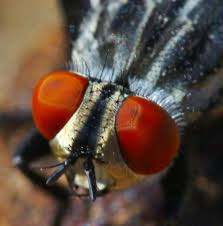Facts
Sarcophaga crassipalpis has a wide range of uses in the
scientific world. Most notably, S. crassipalpis is one of the
most common flesh flies in laboratory experiments, contributing
information not only about its own genus and species, but about the
entire Insecta class. S. crassipalpis is studied especially
for its well-adapted responses to external stimuli, such as changes
in climate and temperature, light patterns, and availability and
exposure to mates (Nishida 1984). This includes the diapause
process, which takes place during the pupal phase (see
Form and Function).
S. crassipalpis is also used in forensic entomology to
estimate the time of death of potential homicide victims. Studying
the internal physiology of the fly allows forensic entomologists to
determine an approximate time of death, which can help to identify
both the victim and the murderer (Kgware et al.). Unfortunately,
flesh flies are relatively rare colonizers of human remains, but
they most often appear early in the decomposition process (Nishida
1984; Diaz & Kaufman 2011). This makes them a vital contributor to
information when present.
Sex Differences in Behavior
Male flesh flies are much more territorial than female flesh flies.
In the wild, male S. crassipalpis has been known to create
lookout points from which he can pay careful attention to his
surroundings; when other insects invade, he attacks. When a female
enters his territory, he can capture her as a potential mate.
Studies have provided evidence that male territoriality is not
related to defending resources but to establishing dominance and
increasing one’s chances of finding a mate. S. crassipalpis
females, on the other hand, are much more likely to exhibit
tolerance toward other individuals (Paquette et al. 2008). For
more on how behavioral differences in the sexes affect mating, visit
our Reproduction page.
Danger
 S. crassipalpis is relatively benign to humans, although they
can be vectors for leprosy-causing bacteria. Furthermore, S.
crassipalpis has been known to causes myiasis in animals, mostly
sheep, but human cases have been reported (Kgware et al.). Cases of
dermal, wound, or ophthalmomyiasis have been seen in humans when fly
larvae are deposited under the skin, in open wounds, or in or near
the eyes, respectively (Uni et al. 1999). These infections cause
itchy sores and pus-filled lesions (Kgware et al.).
Ophthalmomyiasis can also cause swelling of the eyelids, optical
discharge, and conjunctivitis (Uni et al. 1999). Still, it is
important to keep in mind that such cases are rare and that
treatment is readily available in the United States.
S. crassipalpis is relatively benign to humans, although they
can be vectors for leprosy-causing bacteria. Furthermore, S.
crassipalpis has been known to causes myiasis in animals, mostly
sheep, but human cases have been reported (Kgware et al.). Cases of
dermal, wound, or ophthalmomyiasis have been seen in humans when fly
larvae are deposited under the skin, in open wounds, or in or near
the eyes, respectively (Uni et al. 1999). These infections cause
itchy sores and pus-filled lesions (Kgware et al.).
Ophthalmomyiasis can also cause swelling of the eyelids, optical
discharge, and conjunctivitis (Uni et al. 1999). Still, it is
important to keep in mind that such cases are rare and that
treatment is readily available in the United States.
Pest Management
Flesh flies rarely inhabit houses or restaurants, preferring instead
the resources offered by the outdoors, including manure and decay
(Kgware et al.). In rare cases where S. crassipalpis has
become a problem, the elimination of food sources for larvae (most
often animal carcasses) and for adults (vegetable matter, especially
decayed) has been sufficient to remove the infestation (Diaz &
Kaufman 2011). For more information on the management of flesh
flies and other vermin, see the
University of Florida Guide to Household Pests.
Click here to return to the home page.
